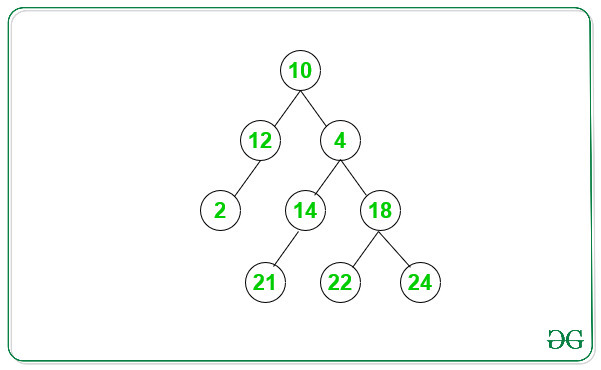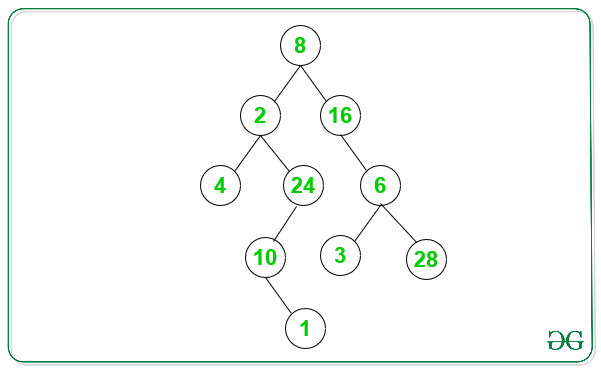Dado un árbol binario , la tarea es contar el número de caminos pares en el árbol binario dado. Even Path es una ruta en la que la ruta de raíz a hoja contiene todos los Nodes pares solamente.
Ejemplos:
Entrada: A continuación se muestra el árbol binario dado:
Salida: 3
Explicación:
Hay 3 rutas pares para el árbol binario anterior:
1. 10->12->2
2. 10->4->18->22
3. 10->4->18->24Entrada: A continuación se muestra el árbol binario dado:
Salida: 2
Explicación:
Hay 2 rutas pares para el árbol binario anterior:
1. 8->2->4
2. 8->16->6->28
Enfoque ingenuo: la idea es generar toda la ruta de la raíz a la hoja y verificar si todos los Nodes en cada ruta son pares o no. Cuente todos los caminos con Nodes pares y devuelva el conteo. La implementación anterior requiere espacio adicional para almacenar la ruta.
Enfoque eficiente: la idea es usar Preorder Tree Traversal . Durante el recorrido previo al pedido del árbol binario dado, haga lo siguiente:
- Si el valor actual del Node es impar o el puntero se convierte en NULL , devuelva el recuento.
- Si el Node actual es un Node hoja, incremente el conteo en 1.
- Llame recursivamente al subárbol izquierdo y derecho con el recuento actualizado.
- Después de las llamadas totalmente recursivas, el valor de count es el número de caminos pares para un árbol binario dado.
A continuación se muestra la implementación del enfoque anterior:
C++
// C++ program for the above approach
#include <bits/stdc++.h>
using namespace std;
// A Tree node
struct Node {
int key;
struct Node *left, *right;
};
// Utility function to create a new node
Node* newNode(int key)
{
Node* temp = new Node;
temp->key = key;
temp->left = temp->right = NULL;
return (temp);
}
// Utility function to count the even path
// in a given Binary tree
int evenPaths(struct Node* node, int count)
{
// Base Condition, when node pointer
// becomes null or node value is odd
if (node == NULL || (node->key % 2 != 0)) {
return count;
}
// Increment count when encounter leaf
// node with all node value even
if (!node->left && !node->right) {
count++;
}
// Left recursive call, and save the
// value of count
count = evenPaths(node->left, count);
// Right recursive call, and return
// value of count
return evenPaths(node->right, count);
}
// Function to count the even paths in a
// given Binary tree
int countEvenPaths(struct Node* node)
{
// Function call with count = 0
return evenPaths(node, 0);
}
// Driver Code
int main()
{
// Tree
Node* root = newNode(12);
root->left = newNode(13);
root->right = newNode(12);
root->right->left = newNode(14);
root->right->right = newNode(16);
root->right->left->left = newNode(21);
root->right->left->right = newNode(22);
root->right->right->left = newNode(22);
root->right->right->right = newNode(24);
root->right->right->right->left = newNode(8);
// Function call
cout << countEvenPaths(root);
return 0;
}
Java
// Java program for the above approach
import java.util.*;
class GFG{
// A Tree node
static class Node {
int key;
Node left, right;
};
// Utility function to create a new node
static Node newNode(int key)
{
Node temp = new Node();
temp.key = key;
temp.left = temp.right = null;
return (temp);
}
// Utility function to count the even path
// in a given Binary tree
static int evenPaths(Node node, int count)
{
// Base Condition, when node pointer
// becomes null or node value is odd
if (node == null || (node.key % 2 != 0)) {
return count;
}
// Increment count when encounter leaf
// node with all node value even
if (node.left == null && node.right == null) {
count++;
}
// Left recursive call, and save the
// value of count
count = evenPaths(node.left, count);
// Right recursive call, and return
// value of count
return evenPaths(node.right, count);
}
// Function to count the even paths in a
// given Binary tree
static int countEvenPaths(Node node)
{
// Function call with count = 0
return evenPaths(node, 0);
}
// Driver Code
public static void main(String args[])
{
// Tree
Node root = newNode(12);
root.left = newNode(13);
root.right = newNode(12);
root.right.left = newNode(14);
root.right.right = newNode(16);
root.right.left.left = newNode(21);
root.right.left.right = newNode(22);
root.right.right.left = newNode(22);
root.right.right.right = newNode(24);
root.right.right.right.left = newNode(8);
// Function call
System.out.println(countEvenPaths(root));
}
}
// This code is contributed by AbhiThakur
Python3
# Python3 program for the # above approach # A Tree node class Node: def __init__(self, x): self.key = x self.left = None self.right = None # Utility function to count # the even path in a given # Binary tree def evenPaths(node, count): # Base Condition, when node # pointer becomes null or # node value is odd if (node == None or (node.key % 2 != 0)): return count # Increment count when # encounter leaf node # with all node value even if (not node.left and not node.right): count+=1 # Left recursive call, and # save the value of count count = evenPaths(node.left, count) # Right recursive call, and # return value of count return evenPaths(node.right, count) # Function to count the even # paths in a given Binary tree def countEvenPaths(node): # Function call with count = 0 return evenPaths(node, 0) # Driver Code if __name__ == '__main__': #Tree root = Node(12) root.left = Node(13) root.right = Node(12) root.right.left = Node(14) root.right.right = Node(16) root.right.left.left = Node(21) root.right.left.right = Node(22) root.right.right.left = Node(22) root.right.right.right = Node(24) root.right.right.right.left = Node(8) #Function call print(countEvenPaths(root)) # This code is contributed by Mohit Kumar 29
C#
// C# program for the above approach
using System;
class GFG{
// A Tree node
class Node {
public int key;
public Node left, right;
};
// Utility function to create a new node
static Node newNode(int key)
{
Node temp = new Node();
temp.key = key;
temp.left = temp.right = null;
return (temp);
}
// Utility function to count the even path
// in a given Binary tree
static int evenPaths(Node node, int count)
{
// Base Condition, when node pointer
// becomes null or node value is odd
if (node == null || (node.key % 2 != 0)) {
return count;
}
// Increment count when encounter leaf
// node with all node value even
if (node.left == null && node.right == null) {
count++;
}
// Left recursive call, and save the
// value of count
count = evenPaths(node.left, count);
// Right recursive call, and return
// value of count
return evenPaths(node.right, count);
}
// Function to count the even paths in a
// given Binary tree
static int countEvenPaths(Node node)
{
// Function call with count = 0
return evenPaths(node, 0);
}
// Driver Code
public static void Main(String []args)
{
// Tree
Node root = newNode(12);
root.left = newNode(13);
root.right = newNode(12);
root.right.left = newNode(14);
root.right.right = newNode(16);
root.right.left.left = newNode(21);
root.right.left.right = newNode(22);
root.right.right.left = newNode(22);
root.right.right.right = newNode(24);
root.right.right.right.left = newNode(8);
// Function call
Console.WriteLine(countEvenPaths(root));
}
}
// This code is contributed by PrinciRaj1992
Javascript
<script>
// Javascript program for the above approach
// A Tree node
class Node
{
// Utility function to create
// a new node
constructor(key)
{
this.key = key;
this.left = this.right = null;
}
}
// Utility function to count the even path
// in a given Binary tree
function evenPaths(node, count)
{
// Base Condition, when node pointer
// becomes null or node value is odd
if (node == null || (node.key % 2 != 0))
{
return count;
}
// Increment count when encounter leaf
// node with all node value even
if (node.left == null && node.right == null)
{
count++;
}
// Left recursive call, and save the
// value of count
count = evenPaths(node.left, count);
// Right recursive call, and return
// value of count
return evenPaths(node.right, count);
}
// Function to count the even paths in a
// given Binary tree
function countEvenPaths(node)
{
// Function call with count = 0
return evenPaths(node, 0);
}
// Driver Code
let root = new Node(12);
root.left = new Node(13);
root.right = new Node(12);
root.right.left = new Node(14);
root.right.right = new Node(16);
root.right.left.left = new Node(21);
root.right.left.right = new Node(22);
root.right.right.left = new Node(22);
root.right.right.right = new Node(24);
root.right.right.right.left = new Node(8);
// Function call
document.write(countEvenPaths(root));
// This code is contributed by unknown2108
</script>
3
Complejidad de tiempo: O(N), donde N es el número de Nodes en el árbol binario dado.
Publicación traducida automáticamente
Artículo escrito por MohammadMudassir y traducido por Barcelona Geeks. The original can be accessed here. Licence: CCBY-SA

